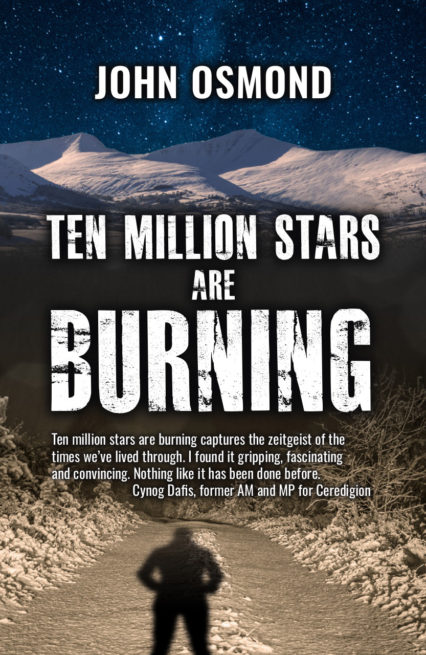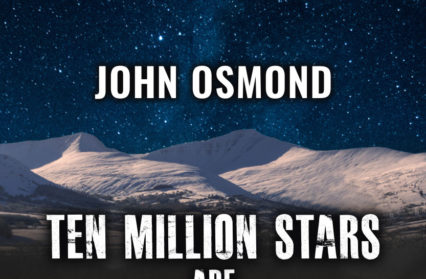
Emma Schofield reviews the epic, Ten Million Stars Are Burning, which is a novel by John Osmond that explores a welsh political struggle.
The word epic is frequently overused in today’s society, but in the case of John Osmond’s political fiction offering, Ten Million Stars Are Burning, it is arguably the aptest description. Standing at a staggering 602 pages, this is definitely not a novel for the faint-hearted. It’s an undertaking that would likely have daunted many authors, but Osmond is ideally placed to write such a novel. With a rich background in Welsh politics behind him, in which he has been prominent as a journalist, commentator, television producer and a director of the Institute of Welsh Affairs, Osmond has much to say about a topic which proved to both exciting and divisive in 1970s Wales. The novel draws on this vast experience to bring together history and fiction in a substantial account of the events which led towards the dramatic referendum result against devolution for Wales in 1979 when the prospect of a Welsh Assembly was comprehensively rejected by voters.
Focusing on events taking place over a period of just six years, Ten Million Stars Are Burning seeks to depict this political struggle from the perspective of two very different characters. The story is delivered through the narrative lens of Owen James, a journalist for The Western Mail, and Rhiannon Jones-Davies, a student and prominent Welsh language activist. The political minefield that is Welsh devolution is certainly an interesting topic for a novel and Osmond wastes no time in asserting its importance to understanding modern Welsh identity. Readers may wonder why Osmond has chosen now to write such a text, but as Wales once again ponders its sense of identity, there are a number of eerie parallels between discussions taking place in 2018 and those which pass between the characters in the novel. Likewise, the depiction of the struggle faced by Welsh language campaigners during this period will almost certainly ring familiar to the ears of those who seek to protect the language today.
As complex as it is interesting, the tumultuous period of politics that Osmond depicts is largely unchartered fiction territory at this time, and it makes for interesting reading. Nevertheless, the complexity of the political processes underway in the novel are mirrored by the complexity of the novel itself. This is a novel of specifics, with the narrative focusing on details and intense scenes, ranging from ‘the smoke-filled bar of the Belle Vue hotel’ which features in the opening to Part 1, to dinner tables, parliamentary offices, to on-location filming in various areas of Wales.
Likewise, the character list is substantial with scores of characters, many of them actual historical figures, appearing throughout. For the uninitiated in the mechanics of the 1979 referendum in Wales, this enormous array of characters, along with the detailed notes which accompany them, is a baptism of fire. Characters, major and minor, drift in and out of the narrative in a style that lends the novel a realist feel, but which does bring with it a number of its own problems.
It is in this lengthy character list that some of the more troubling facets of the novel make their way to the surface. Ten Million Stars Are Burning contains over two hundred named characters, but only around a dozen of these characters are female. Osmond would no doubt argue that this worrying statistic is representative of the era it depicts, but it is nonetheless concerning. Surely, amongst the deluge of characters, real and imagined which populate this dense novel, there were more than thirteen women who played a significant part in the political and public events of the 1970s. There is no denying that female characters are important in the novel, with significant portions of the narrative expressed through the eyes of Rhiannon Jones-Davies. Yet, however prominent Rhiannon’s character is within the story, the dearth of similarly influential female figures remains a concern in a book that purports to explore historical events. Rhiannon’s character is very much an alone female voice among a masculine world of politics in Osmond’s novel, an account that may chime uncomfortably with those who remember the era somewhat differently.
All of these thoughts ultimately lead to the question, would this novel ‘work’ for a reader who doesn’t have a pre-existing knowledge of Wales’ complex relationship with devolution? The answer is: probably not. Allowances have been made for readers without this knowledge, but these are in the form of lengthy biographies, additional notes and character lists. It is easy to imagine how these features may seem daunting, rather than helpful when approaching the novel. The sheer volume of information may well put off as many readers as it encourages. It may be that Osmond would have benefited from a more judicious editorial process.
The real challenge for a novel of this kind is to find a balance between history and fiction. Such a balance requires all the precision of a tightrope walker. At times Osmond maintains this balance, particularly in the presentation of the conscientious and often troubled journalist, Owen James. Yet at other times, the balancing act teeters perilously towards a fiction that does not wholly ring true. There is something raw about Ten Million Stars Are Burning which almost feels as if it was rushed out while it is was still owed some further thought, perhaps nudged out into the world before it was fully ready. There are, undoubtedly, so many questions regarding identity, regionalism, nationalism and political unity worthy of attention raised by the novel, but to address them all at once in a book of this proportion is certainly confronting.
For those readers with the stamina to endure, there may well be more ahead. Osmond has indicated his intention to make Ten Million Stars Are Burning the first in a trilogy that will continue to follow the story of Wales’ journey towards devolution in the proceeding decades. Whether these two further novels will adopt the same form, and length, as this first one remains to be seen. Regardless, there is much here for readers to consider and, as Britain once again undergoes a deeply uncertain period of politics, there is something timely and reassuring in Osmond’s fictional depiction of another referendum that divided opinion across a nation.
Ten Million Stars Are Burning is available now from Gomer.
Emma Schofield has written a variety of articles for Wales Arts Review.











